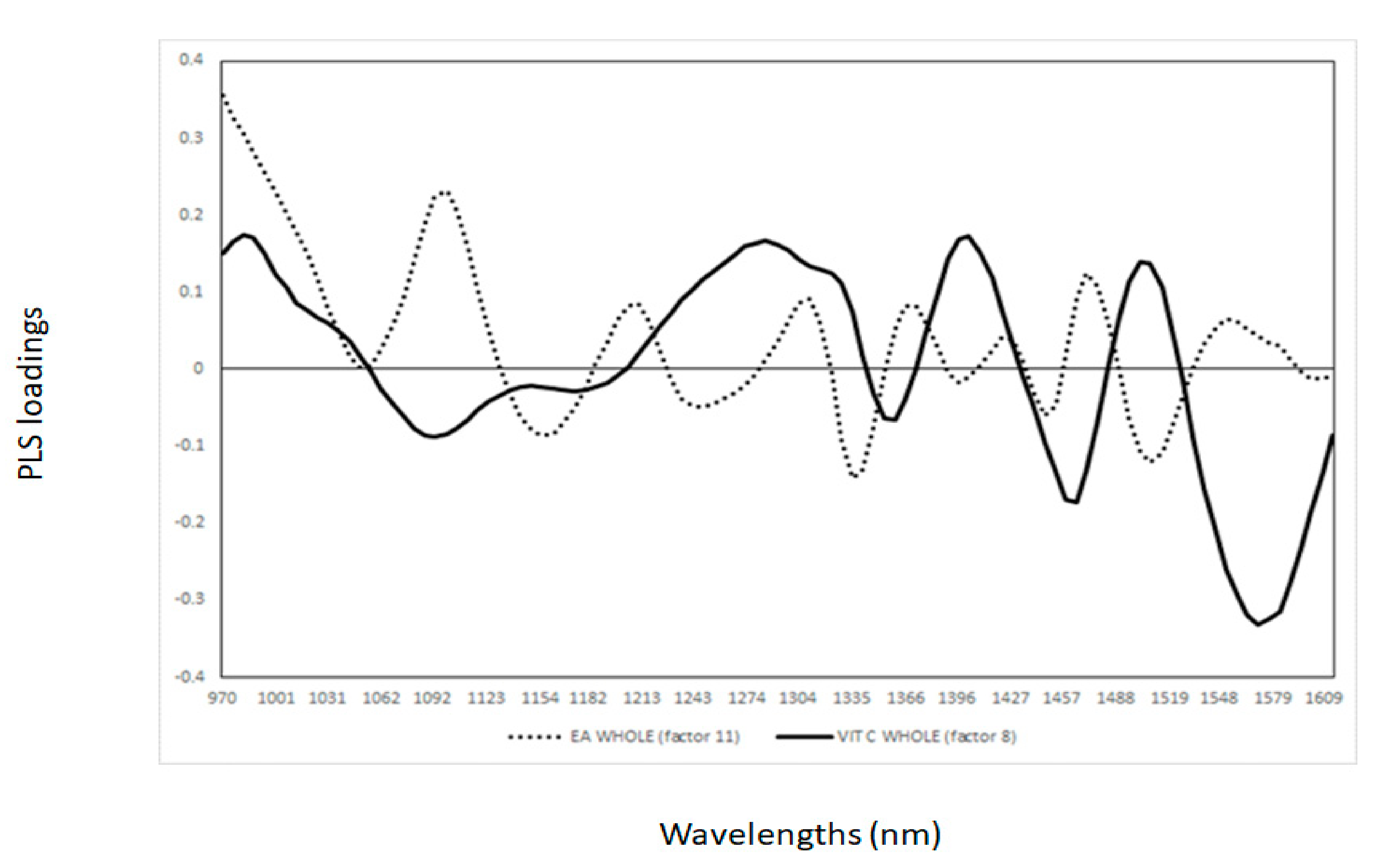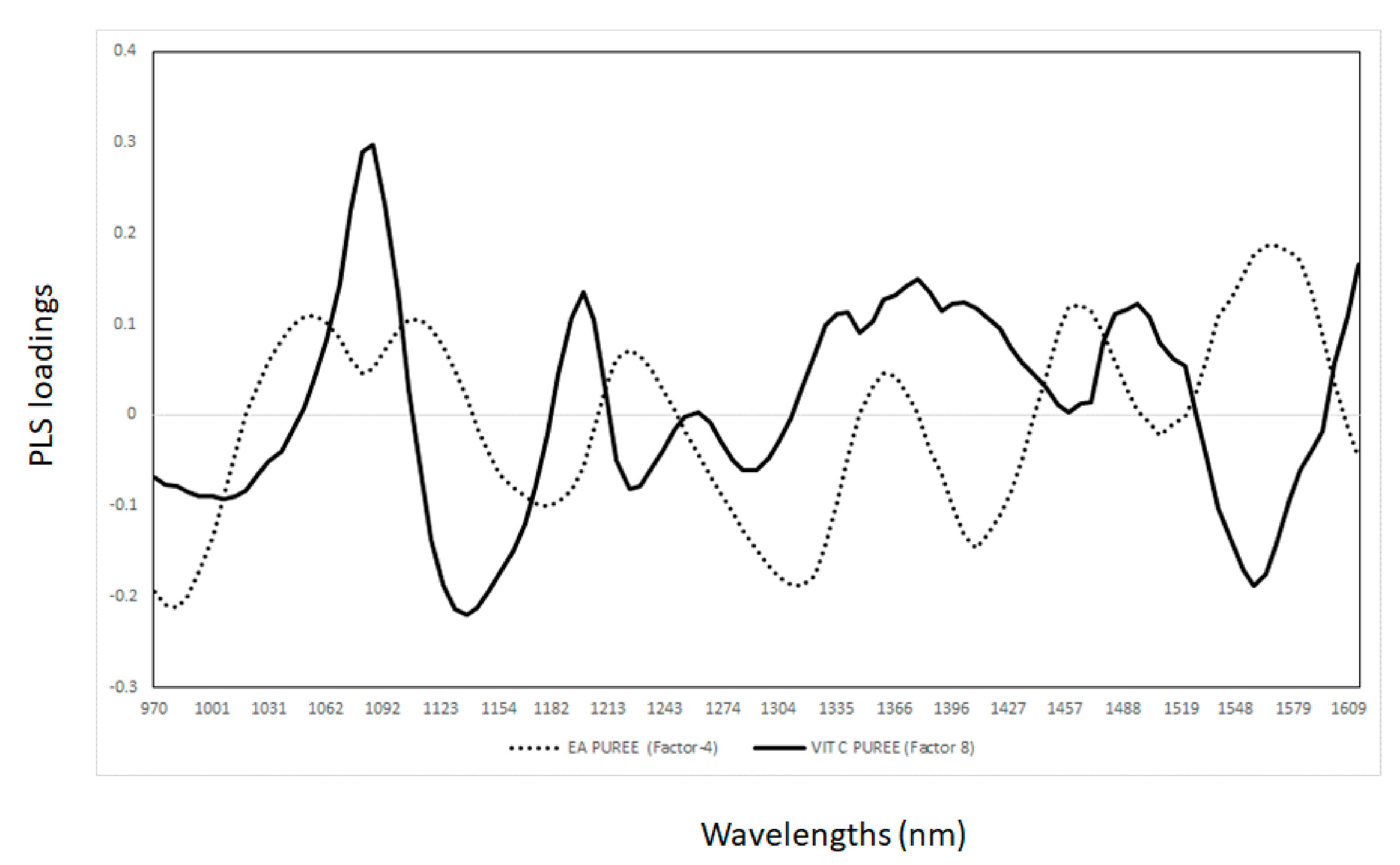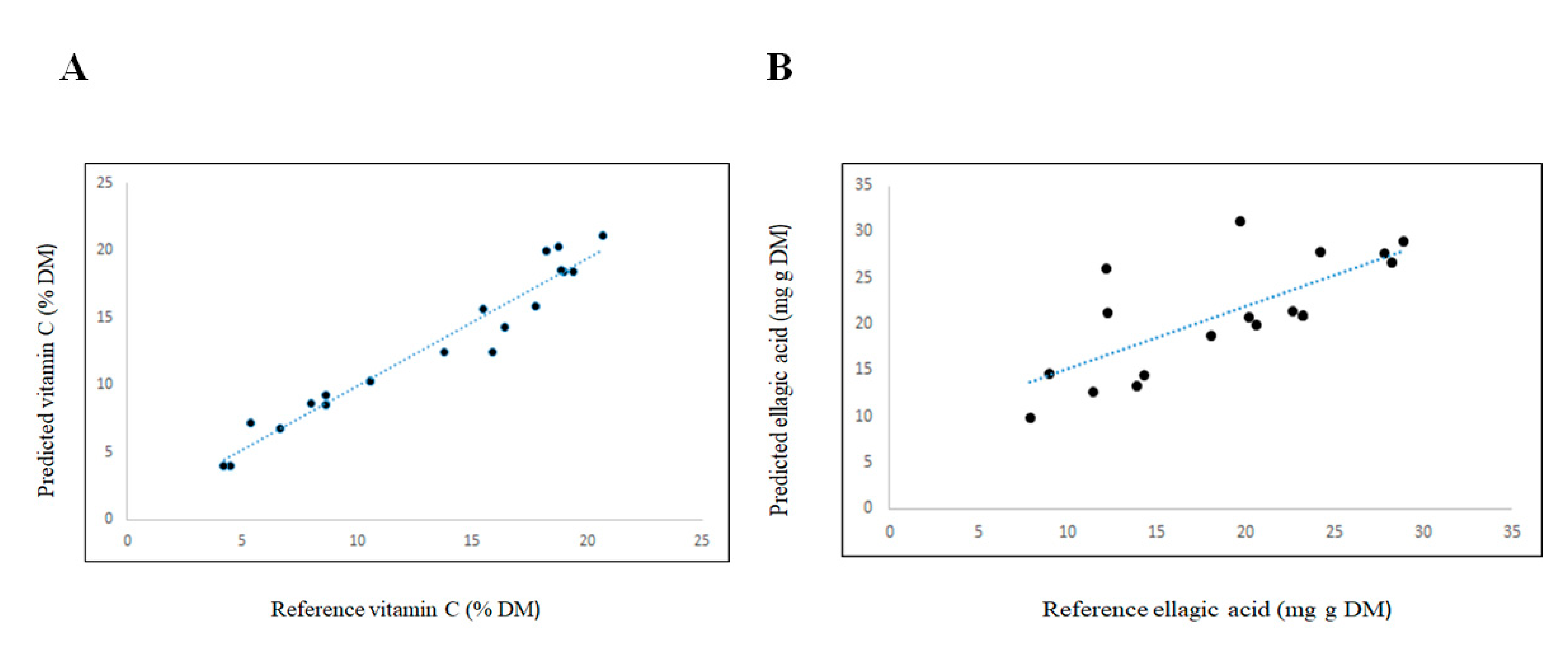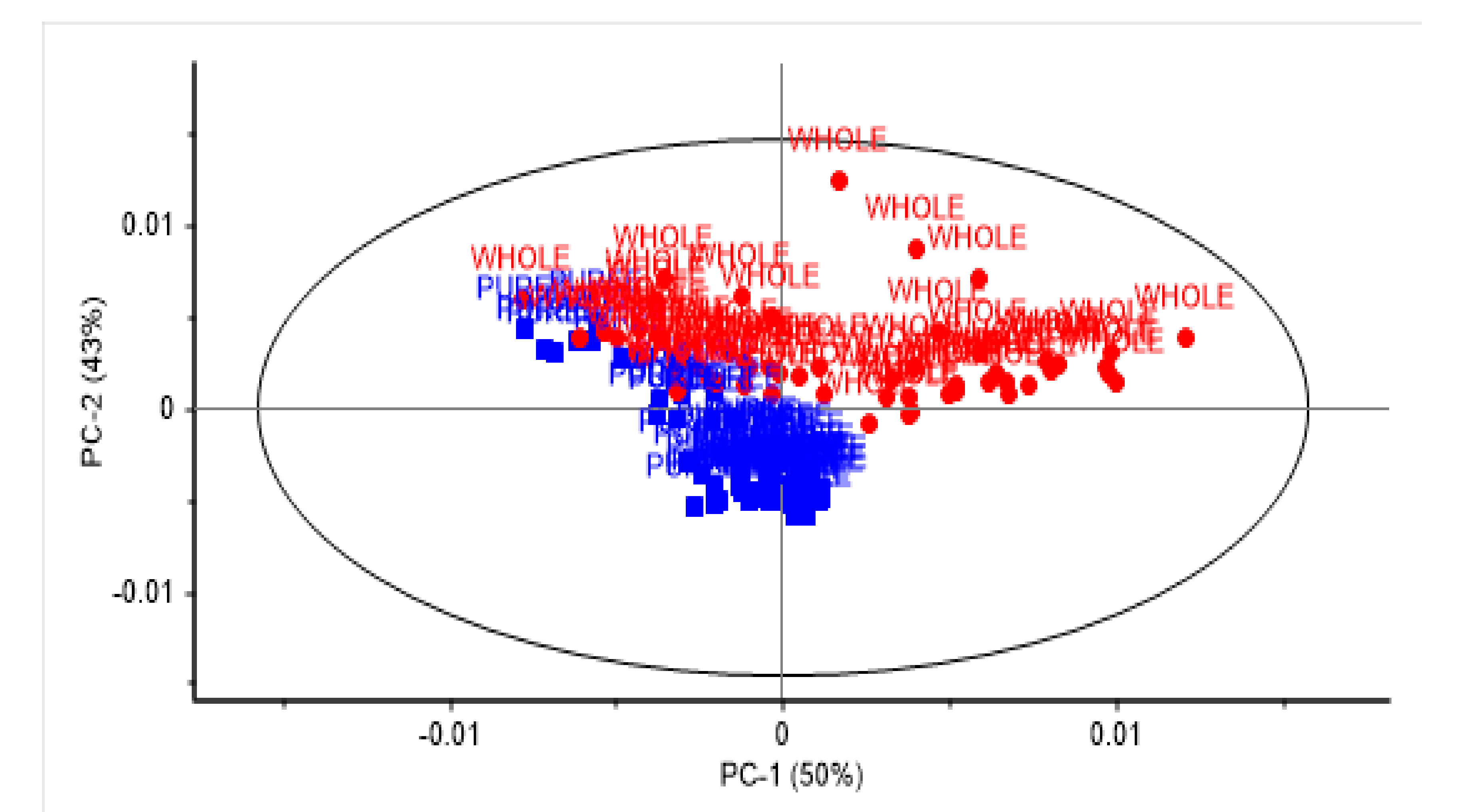The Use of a Micro Near Infrared Portable Instrument to Predict Bioactive Compounds in a Wild Harvested Fruit—Kakadu Plum (Terminalia ferdinandiana)
Abstract
:1. Introduction
2. Materials and Methods
2.1. Samples
2.2. Infrared Spectroscopic Measurements
2.3. Determination of Ellagic Acid
2.4. Determination of Vitamin C
2.5. Data Analysis
3. Results and Discussion
4. Conclusions
Author Contributions
Funding
Acknowledgments
Conflicts of Interest
References
- Netzel, M.; Netzel, G.; Tian, Q.; Schwartz, S.; Konczak, I. Native Australian fruits—A novel source of antioxidants for food. Innov. Food Sci. Emerg. Technol. 2007, 8, 339–346. [Google Scholar] [CrossRef]
- Konczak, I.; Maillot, F.; Dalar, A. Phytochemical divergence in 45 accessions of Terminalia ferdinandiana (Kakadu plum). Food Chem. 2014, 151, 248–256. [Google Scholar] [CrossRef]
- Konczak, I.; Zabaras, D.; Dunstan, M.; Aguas, P. Antioxidant capacity and hydrophilic phytochemicals in commercially grown native Australian fruits. Food Chem. 2010, 123, 1048–1054. [Google Scholar] [CrossRef]
- Konczak, I.; Zabaras, D.; Dunstan, M.; Aguas, P.; Roulfe, P.; Pavan, A. Health Benefits of Australian Native Foods: An Evaluation of Health-Enhancing Compounds; RIRDC: Canberra, Australia, 2009. [Google Scholar]
- Williams, D.J.; Edwards, D.; Pun, S.; Chaliha, M.; Sultanbawa, Y. Profiling ellagic acid content: The importance of form and ascorbic acid levels. Food Res. Int. 2014, 66, 100–106. [Google Scholar] [CrossRef] [Green Version]
- Williams, D.J.; Edwards, D.; Pun, S.; Chaliha, M.; Burren, B.; Tinggi, U.; Sultanbawa, Y. Organic acids in Kakadu plum (Terminalia ferdinandiana): The good (ellagic), the bad (oxalic) and the uncertain (ascorbic). Food Res. Int. 2016, 89, 237–244. [Google Scholar] [CrossRef] [Green Version]
- Sultanbawa, Y. Processing of native plant foods and ingredients. In Australian Native Plants; Cultivation and Uses in the Health and Food Industries; CRC Press: Boca Raton, FL, USA, 2016. [Google Scholar]
- Nicolai, B.M.; Beullens, K.; Bobelyn, E.; Peirs, A.; Saeys, W.; Theron, K.I.; Lammertyn, J. Non-destructive measurement of fruit and vegetable quality by means of NIR spectroscopy: A review. Postharvest Biol. Technol. 2007, 46, 99–118. [Google Scholar] [CrossRef]
- Sorak, D.; Herberholz, L.; Iwascek, S.; Altinpinar, S.; Pfeifer, F.; Siesler, H.W. New developments and applications of handheld Raman, mid-infrared, and near infrared spectrometers. App. Spectrosc. Rev. 2012, 47, 83–115. [Google Scholar] [CrossRef]
- Bec, K.B.; Huck, C.W. Breakthrough Potential in Near-Infrared Spectroscopy: Spectra Simulation. A Review of Recent Developments. Front. Chem. 2019. [Google Scholar] [CrossRef] [Green Version]
- Saeys, W.; Trong, N.N.D.; Van Beers, R.; Nicolaï, B.M. Multivariate calibration of spectroscopic sensors for postharvest quality evaluation: A review. Postharvest Biol. Technol. 2019, 158, 110981. [Google Scholar] [CrossRef]
- Cattaneo, T.; Stellari, A. Review: NIR Spectroscopy as a Suitable Tool for the Investigation of the Horticultural Field. Agronomy 2019, 9, 503. [Google Scholar] [CrossRef] [Green Version]
- Beć, K.B.; Grabska, J.E.; Huck, C.W. Near-Infrared Spectroscopy in Bio-Applications. Molecules 2020, 25, 2948. [Google Scholar] [CrossRef]
- Crocombe, R.A. Portable Spectroscopy. Appl. Spectrosc. 2018, 72, 1701–1751. [Google Scholar] [CrossRef] [PubMed]
- Campos, F.M.; Ribeiro, S.M.R.; Della Lucia, C.M.; Pinheiro-Sant’Ana, H.M.; Stringheta, P.C. Optimization of methodology to analyze ascorbic and dehydroascorbic acid in vegetables. Química Nova 2009, 32, 87–91. [Google Scholar] [CrossRef]
- Spinola, V.; Mendes, B.; Camara, J.S.; Castilho, P.C. An improved and fast UHPLC-PDA methodology for determination of L-ascorbic and dehydroascorbic acids in fruits and vegetables. Evaluation of degradation rate during storage. Anal. Bioanal. Chem. 2012, 403, 1049–1058. [Google Scholar] [CrossRef] [Green Version]
- Savitzky, A.; Golay, M.J.E. Smoothing and Differentiation of Data by Simplified Least Squares Procedures. Anal. Chem. 1964, 36, 1627–1639. [Google Scholar] [CrossRef]
- Bureau, S.; Cozzolino, D.; Clark, C. Contributions of Fourier-transform mid infrared (FT-MIR) spectroscopy to the study of fruit and vegetables: A review. Postharvest Boil. Technol. 2019, 148, 1–14. [Google Scholar] [CrossRef]
- Kennard, R.W.; Stone, L.A. Computer Aided Design of Experiments. Technometrics 1969, 11, 137–148. [Google Scholar] [CrossRef]
- Williams, P.; Dardenne, P.; Flinn, P. Tutorial: Items to be included in a report on a near infrared spectroscopy project. J. Near Infrared Spectrosc. 2017, 25, 85–90. [Google Scholar] [CrossRef]
- Cozzolino, D. The sample, the spectra and the maths–the critical pillars in the development of robust and sound vibrational spectroscopy applications. Molecules 2020, 25, 3674. [Google Scholar] [CrossRef] [PubMed]
- Williams, P.; Norris, K. Near-Infrared Technology in the Agricultural and Food Industries; American Association of Cereal Chemist: St. Paul, MN, USA, 2002. [Google Scholar]
- Toledo-Martín, E.M.; García-García, M.C.; Font, R.; Moreno-Rojas, J.M.; Gómez, P.; Salinas-Navarro, M.; Del Río-Celestino, M. Application of visible/near-infrared reflectance spectroscopy for predicting internal and external quality in pepper. J. Sci. Food Agric. 2016, 96, 3114–3125. [Google Scholar] [CrossRef]
- Conrad, A.O.; Rodriguez-Saona, L.E.; McPherson, B.A.; Wood, D.L.; Bonello, P. Identification of Quercus agrifolia (coast live oak) resistant to the invasive pathogen Phytophthora ramorum in native stands using Fourier transform infrared (FT-IR) spectroscopy. Front. Plant Sci. 2014, 5, 521. [Google Scholar] [CrossRef] [Green Version]
- Murray, I.; Williams, P. Chemical Principals of Near-Infrared Technology. In Near Infrared Technology in the Agricultural and Food Industries; American Association of Cereal Chemists: St. Paul, MN, USA, 1987; pp. 143–167. [Google Scholar]
- Workman, J., Jr.; Weyer, L. Practical Guide to Interpretive Near-Infrared Spectroscopy, 2nd ed.; Taylor & Francis Group: Abingdon, UK; CRC Press: Boca Raton, FL, USA, 2012. [Google Scholar]
- Panicker, C.Y.; Varghese, H.T.; Philip, D. FT-IR, FT-Raman and SERS spectra of Vitamin C. Spectrochim. Acta Part A 2006, 65, 802–804. [Google Scholar] [CrossRef] [PubMed]
- Kramchote, S.; Nakano, K.; Kanlayanarat, S.; Ohashi, S.; Takizawa, K.; Bai, G. Rapid determination of cabbage quality using visible and near-infrared spectroscopy. LWT Food Sci. Technol. 2014, 59, 695–700. [Google Scholar] [CrossRef]
- Maniwara, P.; Nakano, K.; Boonyakiat, D.; Ohashi, S.; Hiroi, M.; Tohyama, T. The use of visible and near infrared spectroscopy for evaluating passion fruit postharvest quality. J. Food Eng. 2014, 143, 33–43. [Google Scholar] [CrossRef]
- Pissard, A.; Fernaandez Pierna, J.A.; Baeten, V.; Sinnaeve, G.; Lognay, G.; Mouteau, A.; Dupont, P.; Rondia, A.; Lateur, M. Non-destructive measurement of vitamin C, total polyphenol and sugar content in apples using near-infrared spectroscopy. J. Sci. Food Agric. 2013, 93, 238–244. [Google Scholar] [CrossRef]
- Rodrigues Borba, K.; Spricigo, P.C.; Aykas, D.P.; Mitsuyuki, M.C.; Colnago, L.A.; Ferreira, M.D. Non-invasive quantification of vitamin C, citric acid, and sugar in ‘Valencia’ oranges using infrared spectroscopies. J. Food Sci. Technol. 2020. [Google Scholar] [CrossRef]
- Tierno, R.; López, A.; Riga, P.; Arazuri, S.; Jarén, C.; Benedicto, L.; Ruiz de Galarreta, J.I. Phytochemicals determination and classification in purple and red fleshed potato tubers by analytical methods and near infrared spectroscopy. J. Sci. Food Agric. 2016, 96, 1888–1899. [Google Scholar] [CrossRef] [Green Version]
- Oliveira-Foladora, G.; de Oliveira Bicudo, M.; Forville de Andrade, E.; Renard, C.M.G.; Bureau, S.; de Castilhos, F. Quality traits prediction of the passion fruit pulp using NIR and MIR Spectroscopy. LWT Food Sci. Technol. 2018, 95, 172–178. [Google Scholar] [CrossRef]




| % DM | VIT C (% DM) | EA (mg g−1 DM) | |
|---|---|---|---|
| Average | 16.4 | 12.5 | 20.64 |
| SD | 1.2 | 3.81 | 7.7 |
| Minimum | 14.2 | 7.8 | 7.6 |
| Maximum | 18.7 | 19.3 | 31.5 |
| CV (%) | 7.3 | 30.4 | 37.4 |
| R2CV | SECV | Slope | Bias | LV | RPDCV | r | SEP | ||
|---|---|---|---|---|---|---|---|---|---|
| Whole | VIT C (% DM) | 0.55 | 1.81 | 0.53 | 0.029 | 8 | 2.1 | 0.85 | 2.0 |
| EA (mg g−1 DM) | 0.57 | 3.8 | 0.61 | −0.007 | 11 | 1.96 | 0.55 | 7.5 | |
| Puree | VIT C (% DM) | 0.86 | 1.73 | 0.87 | 0.10 | 8 | 2.2 | 0.89 | 1.9 |
| EA (mg g−1 DM) | 0.48 | 5.6 | 0.57 | 0.002 | 11 | 1.3 | 0.56 | 6.2 |
Publisher’s Note: MDPI stays neutral with regard to jurisdictional claims in published maps and institutional affiliations. |
© 2021 by the authors. Licensee MDPI, Basel, Switzerland. This article is an open access article distributed under the terms and conditions of the Creative Commons Attribution (CC BY) license (http://creativecommons.org/licenses/by/4.0/).
Share and Cite
Bobasa, E.; Phan, A.D.T.; Netzel, M.; Smyth, H.E.; Sultanbawa, Y.; Cozzolino, D. The Use of a Micro Near Infrared Portable Instrument to Predict Bioactive Compounds in a Wild Harvested Fruit—Kakadu Plum (Terminalia ferdinandiana). Sensors 2021, 21, 1413. https://doi.org/10.3390/s21041413
Bobasa E, Phan ADT, Netzel M, Smyth HE, Sultanbawa Y, Cozzolino D. The Use of a Micro Near Infrared Portable Instrument to Predict Bioactive Compounds in a Wild Harvested Fruit—Kakadu Plum (Terminalia ferdinandiana). Sensors. 2021; 21(4):1413. https://doi.org/10.3390/s21041413
Chicago/Turabian StyleBobasa, Eshetu, Anh Dao T. Phan, Michael Netzel, Heather E. Smyth, Yasmina Sultanbawa, and Daniel Cozzolino. 2021. "The Use of a Micro Near Infrared Portable Instrument to Predict Bioactive Compounds in a Wild Harvested Fruit—Kakadu Plum (Terminalia ferdinandiana)" Sensors 21, no. 4: 1413. https://doi.org/10.3390/s21041413






